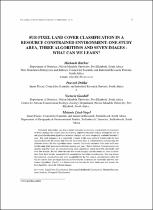 ResearchSpace
ResearchSpace
Sub-pixel land cover classification in a resource constrained environment: One study area, three algorithms and seven images - what can we learn?
JavaScript is disabled for your browser. Some features of this site may not work without it.
- ResearchSpace
- →
- Research Publications/Outputs
- →
- Conference Publications
- →
- View Item
| dc.contributor.author |
Ritchie, Michaela C

|
|
| dc.contributor.author |
Debba, Pravesh

|
|
| dc.contributor.author |
Goodall, V

|
|
| dc.contributor.author |
Lück-Vogel, Melanie

|
|
| dc.date.accessioned | 2020-07-27T06:50:24Z | |
| dc.date.available | 2020-07-27T06:50:24Z | |
| dc.date.issued | 2019-11 | |
| dc.identifier.citation | Ritchie, M.C., Debba, P., Goodall, V. & Lück-Vogel, M. 2019. Sub-pixel land cover classification in a resource constrained environment: One study area, three algorithms and seven images - what can we learn?. In: Annual Proceedings of the South African Statistical Association, SASA Conference 2019, 61st Conference of the SA Statistical Association, Nelson Mandela University South Campus, Port Elizabeth, South Africa, 7-29 November 2019 | en_US |
| dc.identifier.uri | https://journals.co.za/content/journal/10520/EJC-19eabd40a5 | |
| dc.identifier.uri | http://hdl.handle.net/10204/11512 | |
| dc.description | Presented in: Annual Proceedings of the South African Statistical Association, SASA Conference 2019, 61st Conference of the SA Statistical Association, Nelson Mandela University South Campus, Port Elizabeth, South Africa, 7-29 November 2019. https://journals.co.za/content/journal/10520/EJC-19eabd40a5 | en_US |
| dc.description.abstract | Statistical approaches can help environmental managers in resource constrained environments to better manage the areas for which they are responsible by enabling improved decision making through the use of sub-pixel classifications of easier, cheaper and more frequently available Sentinel-2 data. For these managers it is important to know if the same method would yield the best classifications for all seasons and years for their study area. It is known from literature that for different studies, the best algorithm varies, however, this study considers if the same holds true for the same study area across different seasons and years. Seven Sentinel-2 images across two seasons and four years are classified using three algorithms which are both seasonally and own date trained. Results show that the wet season imagery classifications are more accurate than those from the dry season for both seasonal and own date classifications. It is also shown that seasonal classifications are more acceptable for the wet season classifications, while for the dry season there are larger differences between the accuracies for seasonally and own date trained classifications. Finally, it is determined that even for the same study area and season, the best algorithm varies for different images. | en_US |
| dc.language.iso | en | en_US |
| dc.publisher | South African Statistical Association (SASA) | en_US |
| dc.relation.ispartofseries | Workflow;23128 | |
| dc.subject | Land cover classification | en_US |
| dc.subject | Maximum likelihood classification | en_US |
| dc.subject | Mixture discriminant analysis | en_US |
| dc.subject | Sub-pixel classification | en_US |
| dc.title | Sub-pixel land cover classification in a resource constrained environment: One study area, three algorithms and seven images - what can we learn? | en_US |
| dc.type | Conference Presentation | en_US |
| dc.identifier.apacitation | Ritchie, M. C., Debba, P., Goodall, V., & Lück-Vogel, M. (2019). Sub-pixel land cover classification in a resource constrained environment: One study area, three algorithms and seven images - what can we learn?. South African Statistical Association (SASA). http://hdl.handle.net/10204/11512 | en_ZA |
| dc.identifier.chicagocitation | Ritchie, Michaela C, Pravesh Debba, V Goodall, and Melanie Lück-Vogel. "Sub-pixel land cover classification in a resource constrained environment: One study area, three algorithms and seven images - what can we learn?." (2019): http://hdl.handle.net/10204/11512 | en_ZA |
| dc.identifier.vancouvercitation | Ritchie MC, Debba P, Goodall V, Lück-Vogel M, Sub-pixel land cover classification in a resource constrained environment: One study area, three algorithms and seven images - what can we learn?; South African Statistical Association (SASA); 2019. http://hdl.handle.net/10204/11512 . | en_ZA |
| dc.identifier.ris | TY - Conference Presentation AU - Ritchie, Michaela C AU - Debba, Pravesh AU - Goodall, V AU - Lück-Vogel, Melanie AB - Statistical approaches can help environmental managers in resource constrained environments to better manage the areas for which they are responsible by enabling improved decision making through the use of sub-pixel classifications of easier, cheaper and more frequently available Sentinel-2 data. For these managers it is important to know if the same method would yield the best classifications for all seasons and years for their study area. It is known from literature that for different studies, the best algorithm varies, however, this study considers if the same holds true for the same study area across different seasons and years. Seven Sentinel-2 images across two seasons and four years are classified using three algorithms which are both seasonally and own date trained. Results show that the wet season imagery classifications are more accurate than those from the dry season for both seasonal and own date classifications. It is also shown that seasonal classifications are more acceptable for the wet season classifications, while for the dry season there are larger differences between the accuracies for seasonally and own date trained classifications. Finally, it is determined that even for the same study area and season, the best algorithm varies for different images. DA - 2019-11 DB - ResearchSpace DP - CSIR KW - Land cover classification KW - Maximum likelihood classification KW - Mixture discriminant analysis KW - Sub-pixel classification LK - https://researchspace.csir.co.za PY - 2019 T1 - Sub-pixel land cover classification in a resource constrained environment: One study area, three algorithms and seven images - what can we learn? TI - Sub-pixel land cover classification in a resource constrained environment: One study area, three algorithms and seven images - what can we learn? UR - http://hdl.handle.net/10204/11512 ER - | en_ZA |





